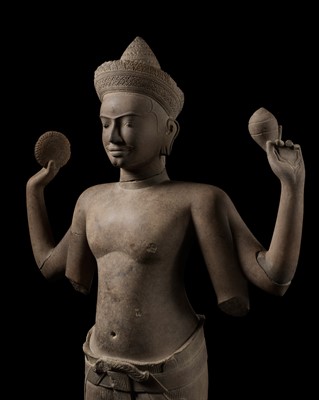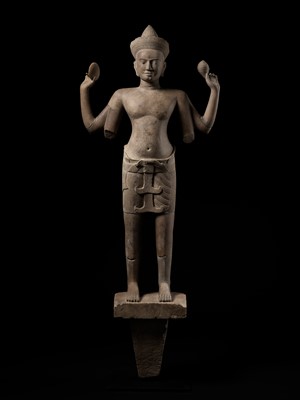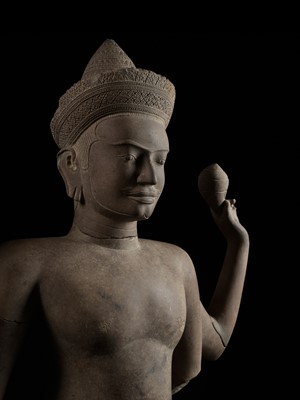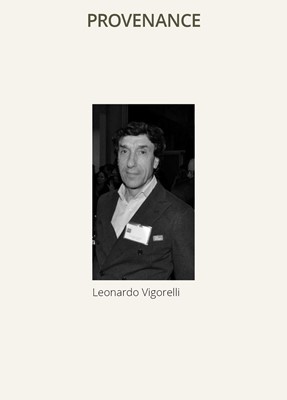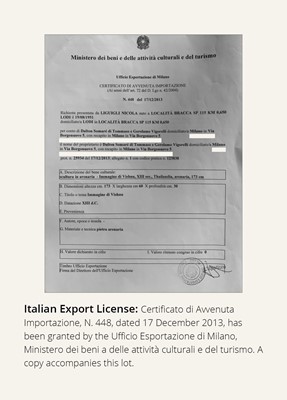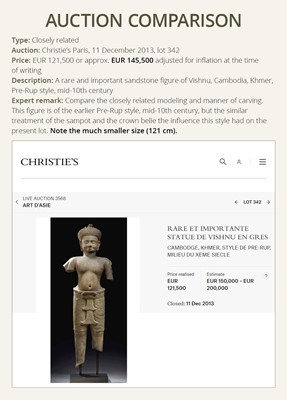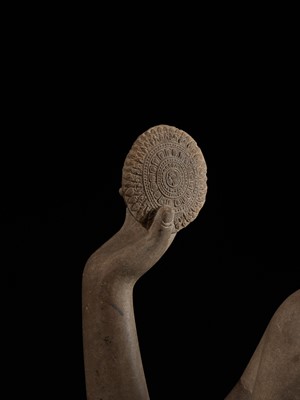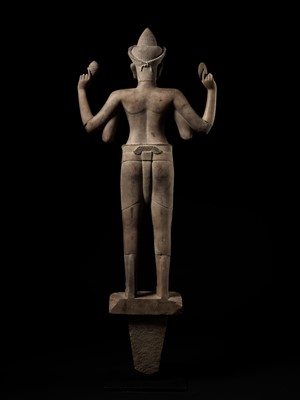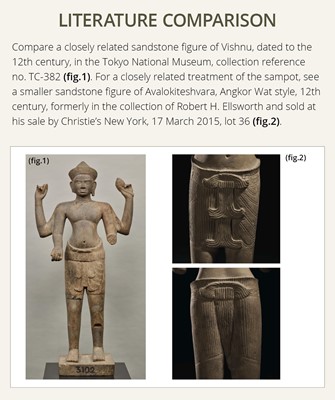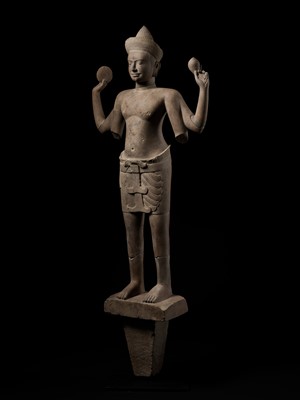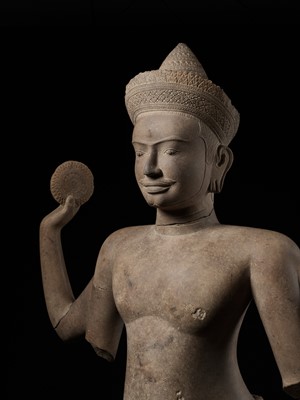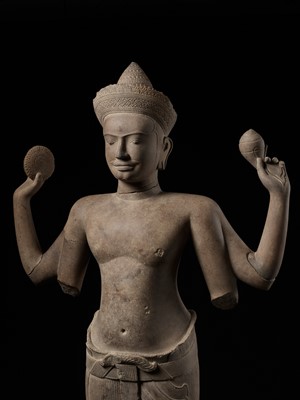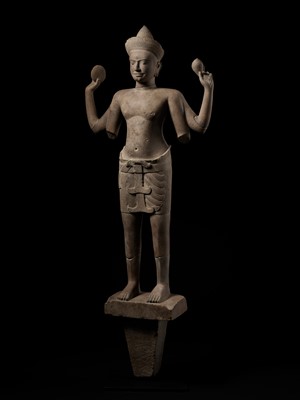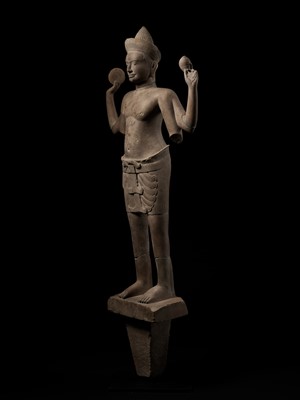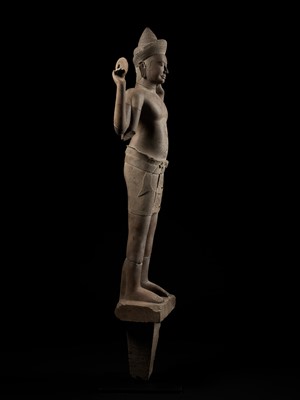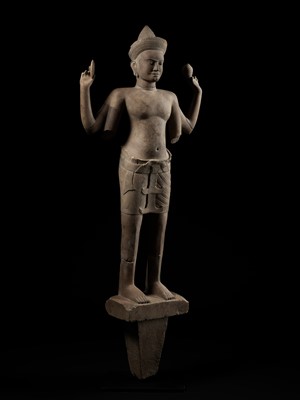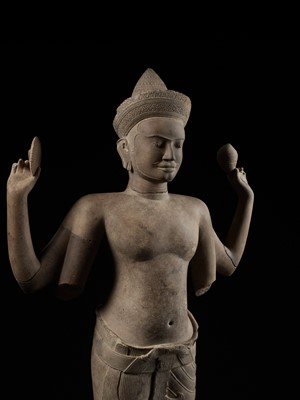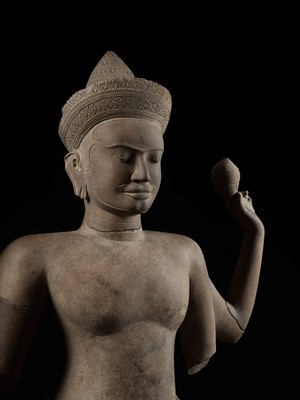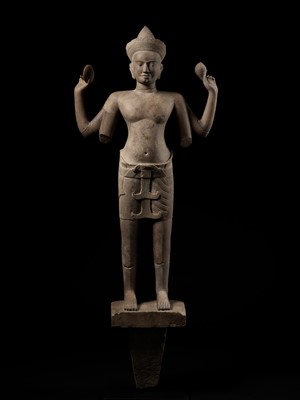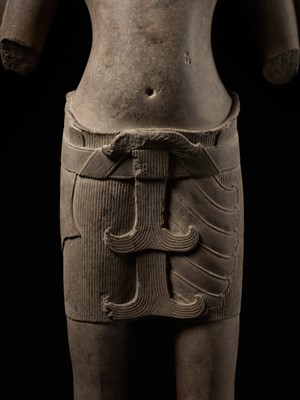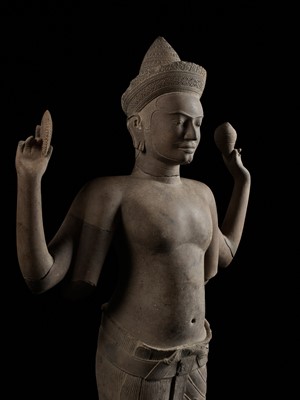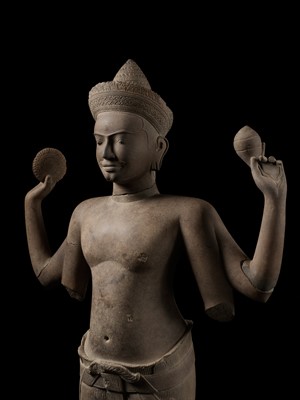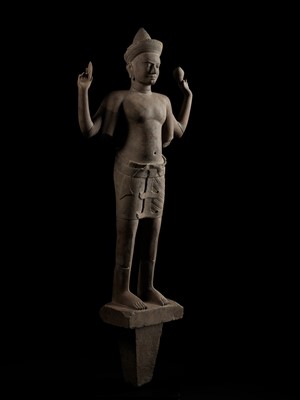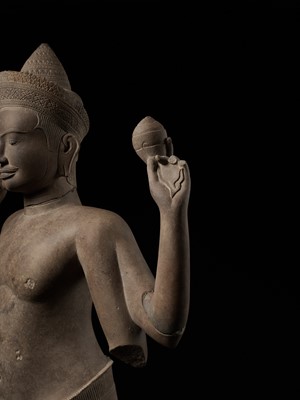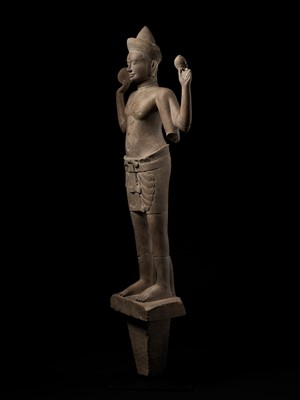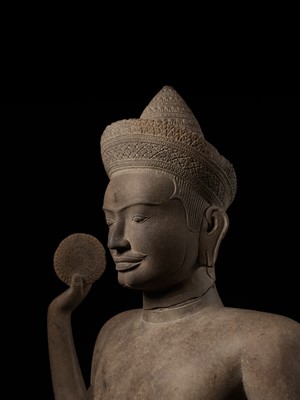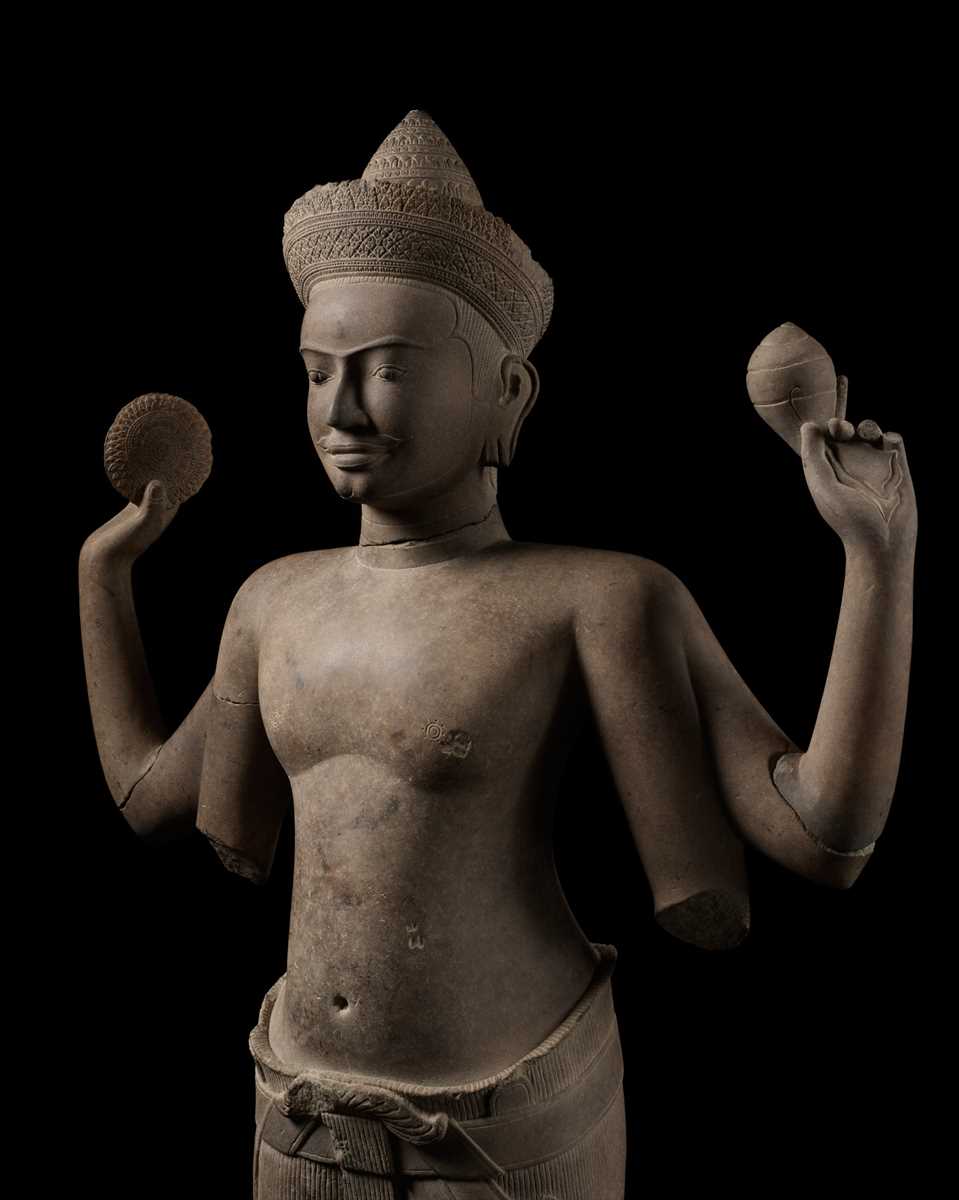11th Apr, 2024 11:00
TWO-DAY AUCTION: Fine Asian Art, Buddhism and Hinduism
183
A RARE AND MONUMENTAL SANDSTONE STATUE OF VISHNU, ANGKOR PERIOD, ANGKOR WAT STYLE
Sold for €97,500
including Buyer's Premium
Khmer Empire, 12th century. The Preserver of the Universe standing in samapada on a rectangular base, holding the conch and chakra in his raised secondary hands. His serene face sensitively modeled with almond-shaped eyes, round pupils, sinuous brow, full lips, and wavy mustache. The hair piled up into an elaborate conical chignon, with neatly incised braids surmounted by towering rows of petals, behind the meticulously carved foliate tiara neatly tied with string at the back.
Provenance: From the collection of Professor Giuseppe Federici, Bologna, Italy, early 1990s. Collection of Leonardo Vigorelli, Bergamo, acquired from the above. Professor Giuseppe Federici was a collector, musician, and traveler, who assembled an eclectic collection containing pieces from across Asia and the world. Leonardo Vigorelli is a retired Italian art dealer and noted collector, specializing in African and ancient Hindu-Buddhist art. After studying anthropology and decades of travel as well as extensive field research in India, the Himalayan region, Southeast Asia, and Africa, he founded the Dalton Somaré art gallery in Milan, Italy, which today is being run by his two sons.
Condition: Good condition, commensurate with age. Extensive wear, losses, some old repairs, signs of weathering and erosion, structural fissures, nicks, and scratches. The stone with a fine, naturally grown, smooth patina overall.
Italian Export License: Certificato di Avvenuta Importazione, N. 448, dated 17 December 2013, has been granted by the Ufficio Esportazione di Milano, Ministero dei beni e delle attività culturali e del turismo. A copy of the document accompanies this lot.
Dimensions: Height 225 cm (incl. tang) and 178 cm (measured from the plinth)
The short sampot is arranged in multiple patterns, including tightly spaced vertical pleats around the right leg enhanced by a fishtail fold and loosely fanned diagonal waves across the left. A double-anchor fold bridges the thighs, the gathered fabric pulled snugly between the legs from the verso and then set in an elegant crest on back and front just below the top, secured with a broad belt.
Angkor Wat, erected by King Suryavarman II (r. 1113 - circa 1150), the great ruler of the Khmer empire, was built both as the royal temple complex dedicated to the Hindu deity Vishnu and as the ruler’s personal mausoleum. The magnitude of this building program underscored the intention of the King to establish his authority and strength as a leader. By linking himself directly to Vishnu, the deity associated with restoring cosmic order, he legitimized his spiritual and worldly power. This is captured aesthetically in the sturdy figural proportions and powerfully frontal images created during his time, evident here in this present sculpture of Vishnu.
The style of Angkor Wat seen here harks back to the earlier styles of the Koh Ker and Pre Rup traditions of the tenth century, rather than the preceding style of the Baphuon period. Lerner states that for a “ruler concerned with martial campaigns and responsible for such a gigantic personal monument as Angkor Wat, the Baphuon figural style may have appeared too consciously unheroic and sensuous.” (see Martin Lerner, Ancient Khmer Sculpture, New York, 1994, p. 46). Instead, rather than soft contours, each element has weight. The sampot for example is made of thick material, and the face and crown show solidity too, with the broad face firmly supporting the conical diadem decorated in a linear and formulaic patterning.
Literature comparison:
Compare a closely related sandstone figure of Vishnu, dated to the 12th century, in the Tokyo National Museum, collection reference no. TC-382. For a closely related treatment of the sampot, see a smaller sandstone figure of Avalokiteshvara, Angkor Wat style, 12th century, formerly in the collection of Robert H. Ellsworth and sold at his sale by Christie’s New York, 17 March 2015, lot 36.
Auction result comparison:
Type: Closely related
Auction: Christie’s Paris, 11 December 2013, lot 342
Price: EUR 121,500 or approx. EUR 145,500 adjusted for inflation at the time of writing
Description: A rare and important sandstone figure of Vishnu, Khmer, Pre-Rup style, mid-10th century
Expert remark: Compare the closely related modeling and manner of carving. This figure is of the earlier Pre-Rup style, mid-10th century, but the similar treatment of the sampot and the crown belie the influence this style had on the present lot. Note the much smaller size (121 cm).
Khmer Empire, 12th century. The Preserver of the Universe standing in samapada on a rectangular base, holding the conch and chakra in his raised secondary hands. His serene face sensitively modeled with almond-shaped eyes, round pupils, sinuous brow, full lips, and wavy mustache. The hair piled up into an elaborate conical chignon, with neatly incised braids surmounted by towering rows of petals, behind the meticulously carved foliate tiara neatly tied with string at the back.
Provenance: From the collection of Professor Giuseppe Federici, Bologna, Italy, early 1990s. Collection of Leonardo Vigorelli, Bergamo, acquired from the above. Professor Giuseppe Federici was a collector, musician, and traveler, who assembled an eclectic collection containing pieces from across Asia and the world. Leonardo Vigorelli is a retired Italian art dealer and noted collector, specializing in African and ancient Hindu-Buddhist art. After studying anthropology and decades of travel as well as extensive field research in India, the Himalayan region, Southeast Asia, and Africa, he founded the Dalton Somaré art gallery in Milan, Italy, which today is being run by his two sons.
Condition: Good condition, commensurate with age. Extensive wear, losses, some old repairs, signs of weathering and erosion, structural fissures, nicks, and scratches. The stone with a fine, naturally grown, smooth patina overall.
Italian Export License: Certificato di Avvenuta Importazione, N. 448, dated 17 December 2013, has been granted by the Ufficio Esportazione di Milano, Ministero dei beni e delle attività culturali e del turismo. A copy of the document accompanies this lot.
Dimensions: Height 225 cm (incl. tang) and 178 cm (measured from the plinth)
The short sampot is arranged in multiple patterns, including tightly spaced vertical pleats around the right leg enhanced by a fishtail fold and loosely fanned diagonal waves across the left. A double-anchor fold bridges the thighs, the gathered fabric pulled snugly between the legs from the verso and then set in an elegant crest on back and front just below the top, secured with a broad belt.
Angkor Wat, erected by King Suryavarman II (r. 1113 - circa 1150), the great ruler of the Khmer empire, was built both as the royal temple complex dedicated to the Hindu deity Vishnu and as the ruler’s personal mausoleum. The magnitude of this building program underscored the intention of the King to establish his authority and strength as a leader. By linking himself directly to Vishnu, the deity associated with restoring cosmic order, he legitimized his spiritual and worldly power. This is captured aesthetically in the sturdy figural proportions and powerfully frontal images created during his time, evident here in this present sculpture of Vishnu.
The style of Angkor Wat seen here harks back to the earlier styles of the Koh Ker and Pre Rup traditions of the tenth century, rather than the preceding style of the Baphuon period. Lerner states that for a “ruler concerned with martial campaigns and responsible for such a gigantic personal monument as Angkor Wat, the Baphuon figural style may have appeared too consciously unheroic and sensuous.” (see Martin Lerner, Ancient Khmer Sculpture, New York, 1994, p. 46). Instead, rather than soft contours, each element has weight. The sampot for example is made of thick material, and the face and crown show solidity too, with the broad face firmly supporting the conical diadem decorated in a linear and formulaic patterning.
Literature comparison:
Compare a closely related sandstone figure of Vishnu, dated to the 12th century, in the Tokyo National Museum, collection reference no. TC-382. For a closely related treatment of the sampot, see a smaller sandstone figure of Avalokiteshvara, Angkor Wat style, 12th century, formerly in the collection of Robert H. Ellsworth and sold at his sale by Christie’s New York, 17 March 2015, lot 36.
Auction result comparison:
Type: Closely related
Auction: Christie’s Paris, 11 December 2013, lot 342
Price: EUR 121,500 or approx. EUR 145,500 adjusted for inflation at the time of writing
Description: A rare and important sandstone figure of Vishnu, Khmer, Pre-Rup style, mid-10th century
Expert remark: Compare the closely related modeling and manner of carving. This figure is of the earlier Pre-Rup style, mid-10th century, but the similar treatment of the sampot and the crown belie the influence this style had on the present lot. Note the much smaller size (121 cm).
Zacke Live Online Bidding
Our online bidding platform makes it easier than ever to bid in our auctions! When you bid through our website, you can take advantage of our premium buyer's terms without incurring any additional online bidding surcharges.
To bid live online, you'll need to create an online account. Once your account is created and your identity is verified, you can register to bid in an auction up to 12 hours before the auction begins.
Intended Spend and Bid Limits
When you register to bid in an online auction, you will need to share your intended maximum spending budget for the auction. We will then review your intended spend and set a bid limit for you. Once you have pre-registered for a live online auction, you can see your intended spend and bid limit by going to 'Account Settings' and clicking on 'Live Bidding Registrations'.
Your bid limit will be the maximum amount you can bid during the auction. Your bid limit is for the hammer price and is not affected by the buyer’s premium and VAT. For example, if you have a bid limit of €1,000 and place two winning bids for €300 and €200, then you will only be able to bid €500 for the rest of the auction. If you try to place a bid that is higher than €500, you will not be able to do so.
Online Absentee and Telephone Bids
You can now leave absentee and telephone bids on our website!
Absentee Bidding
Once you've created an account and your identity is verified, you can leave your absentee bid directly on the lot page. We will contact you when your bids have been confirmed.
Telephone Bidding
Once you've created an account and your identity is verified, you can leave telephone bids online. We will contact you when your bids have been confirmed.
Classic Absentee and Telephone Bidding Form
You can still submit absentee and telephone bids by email or fax if you prefer. Simply fill out the Absentee Bidding/Telephone bidding form and return it to us by email at office@zacke.at or by fax at +43 (1) 532 04 52 20. You can download the PDF from our Upcoming Auctions page.
How-To Guides
How to Create Your Personal Zacke Account
How to Register to Bid on Zacke Live
How to Leave Absentee Bids Online
How to Leave Telephone Bids Online
中文版本的操作指南
创建新账号
注册Zacke Live在线直播竞拍(免平台费)
缺席投标和电话投标
Third-Party Bidding
We partner with best-in-class third-party partners to make it easy for you to bid online in the channel of your choice. Please note that if you bid with one of our third-party online partners, then there will be a live bidding surcharge on top of your final purchase price. You can find all of our fees here. Here's a full list of our third-party partners:
- 51 Bid Live
- EpaiLive
- ArtFoxLive
- Invaluable
- LiveAuctioneers
- the-saleroom
- lot-tissimo
- Drouot
Please note that we place different auctions on different platforms. For example, in general, we only place Chinese art auctions on 51 Bid Live.
Bidding in Person
You must register to bid in person and will be assigned a paddle at the auction. Please contact us at office@zacke.at or +43 (1) 532 04 52 for the latest local health and safety guidelines.
